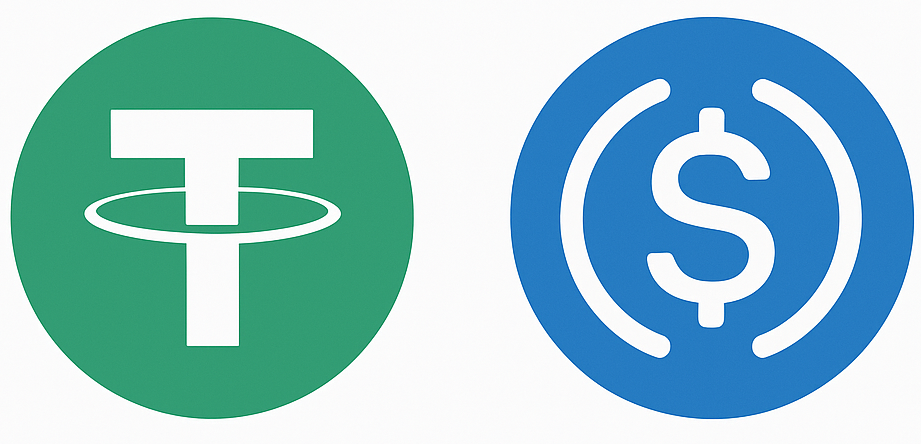Stablecoins: The Bridge Between Crypto and Traditional Finance
The crypto-power financial system emerged from the dissatisfaction surrounding the traditional financial system. Blockchain-based currencies like Bitcoin quickly evolved from something unusual to something commonplace. While people mainly considered Bitcoin as a form of value storage, other forms of cryptocurrency such as Solana or Ethereum emerged. These cryptocurrencies had applications other than being a store of value and thus became popular. However, overall volatility remains the worst enemy of the growth and mainstream adoption of cryptocurrencies, and Stablecoins are an effective solution.
To diminish the unpredictability of the crypto marketplace, stablecoins, pegged to fiat currencies and, in rare cases, commodities, function under the premise of being stablecoins. Thus, a more stable version of cryptocurrencies derives their stability from an underlying stable asset. In today’s world, stablecoins are the medium driving crypto-based interventions, where stability is a prerequisite for innovation to progress.
One could argue that stablecoins are a bridge between the crypto world and the traditional finance world. Today, while Bitcoin and Ethereum can waver by 20% in a day, a stablecoin such as the USDC remains to be $1.00, despite what is going on in the market.
Types Of Stablecoins
Stablecoins or pegged-coins can be classified into varying types based on the asset that backs them. So here are the different types of stablecoins
- Algorithmic stables- These pegged-coins rely on algorithms and supply/demand mechanics rather than collaterals like a fiat currency or RWAs.d into varying types based on the asset that backs them. So here are the different types of stablecoins
- Fiat-backed stables-These pegged-coins are backed by a fiat like the Dollar or the Pound. USDT (Tether) and USDC (Circle) are actually examples of such stables.
- RWA-backed stables- These pegged-coins are backed by real work assets, which are basically tokenized forms of real-world assets (RWAs). Ethena’s USDe is an example of such stablecoins.
- Crypto-backed stables- Some pegged-coins are backed by cryptos like Bitcoins as well. Bima is a project that offers Bitcoin-backed stables.

Representative images of stablecoins – USDT and USDC
How Stablecoins Avert Volatility?
Pegged-coins maintain stability in the market, and here is how they do so
- Algorithmic matching of demand and supply. The price of any asset, including crypto, reacts to the forces of demand and supply. Algorithm-backed stablecoins burn or generate more tokens to stay in sync with the market forces of demand and supply.
- Overcollateralization also helps tackle volatility. So, the asset to which the stablecoin is pegged is in vast excess. Hence, any price fluctuation can be adjusted by increasing or decreasing the volume of the pegged asset.
How And Why Are Stablecoins Useful?
Stablecoins and their utility for traders
Traders are always in need of liquidity. This means that traders search for options where a certain amount of currency X is available in exchange for an equivalent amount of currency Y. Any mismatch in such cases results in a loss of liquidity and prevents many profitable trade decisions. Pegged-coins are used in liquidity pools where they are paired with volatile currencies to reduce impermanent losses. The stablecoins provide stability and minimize slippage, which is the disparity between the anticipated and actual price of the cryptocurrency.
DeFi Operations
DeFi, or decentralized finance, relies heavily on pegged-coins as its primary components. Decentralized finance is regulated by DEXs (decentralized exchanges). DEXs endorse the peer-to-peer exchange of cryptocurrencies without any intermediary control or authority, such as a bank. DEXs need liquidity pools to match the instant demand for currency pairs to ride the tide of the market.
Remittances
Stablecoins offer fast, borderless payments with low fees. You can send $1,000 to someone in another country in seconds—without using a bank.
Alternative For Countries That Have Unstable Currencies
Countries like Venezuela, which has an unstable currency, or countries where the local currency is hyper-volatile, can adopt pegged-coins as their fiat currency to deal with issues of volatility.
Earning Passive Yield Via Stablecoins
Platforms like Spark let you deposit stablecoins like USDC or USDS and earn a predictable APY, thanks to their integrated yield mechanics (e.g., Spark’s Sky Savings Rate).
Stablecoins: The Downside
You have read all about the positives of pegged-coins, but is everything good about these assets, or do they have a downside as well? Similar to any financial construct, pegged-coins also have their drawbacks, and here are some of them.
Depegging
In the crypto realm, people frequently employ the term “depegging,” and it carries substantial weight, particularly when they examine its relevance to stablecoins. When changes in the value of the asset connected to a stablecoin cause it to lose stability, it requires debugging.
Debugging can happen because of changes in regulatory policy.
For example, if a cryptocurrency loses its legal status in any major economy around the world, it could trigger debugging of the stablecoin linked to it. Similarly, fluctuations in the market and mismatches in liquidity can also lead to de-pegging. Finally, a technical glitch in the execution of the smart contract can also result in a debugging event.
Governmental reforms implemented by a central power also cause debugging.
Occasionally, companies or centralized authorities oversee the assets that support stablecoins. When companies or centralized authorities modify their policies, it has an impact on the stability of the stablecoin.
Final Words
These are exciting times when two worlds, financial stability and technological innovation, have converged. That said, pegged-coins are another example of innovation at the intersection of the financial and technology ecosystems. Stablecoins have superior price stability, liquidity, and cross-border potential to eliminate interruptions and allow for seamless transactions. There are drawbacks to pegged-coins, including de-pegging and centralized control. Despite this, pegged-coins will likely continue to play a larger role in the mainstream adoption of crypto as crypto ecosystems keep expanding. Stablecoins provide a hedge against volatility and, more importantly, are building the future of global finance.